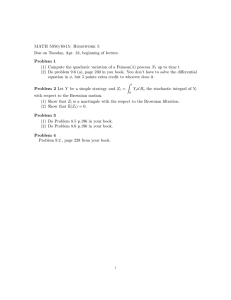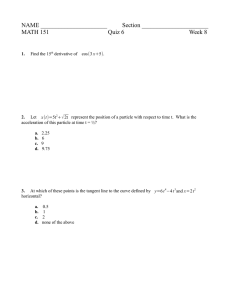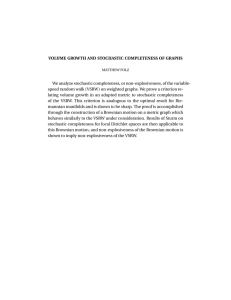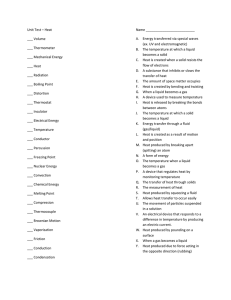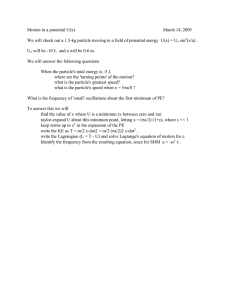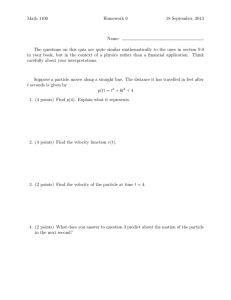Aggregation, condensation and coagulation in particle systems
advertisement
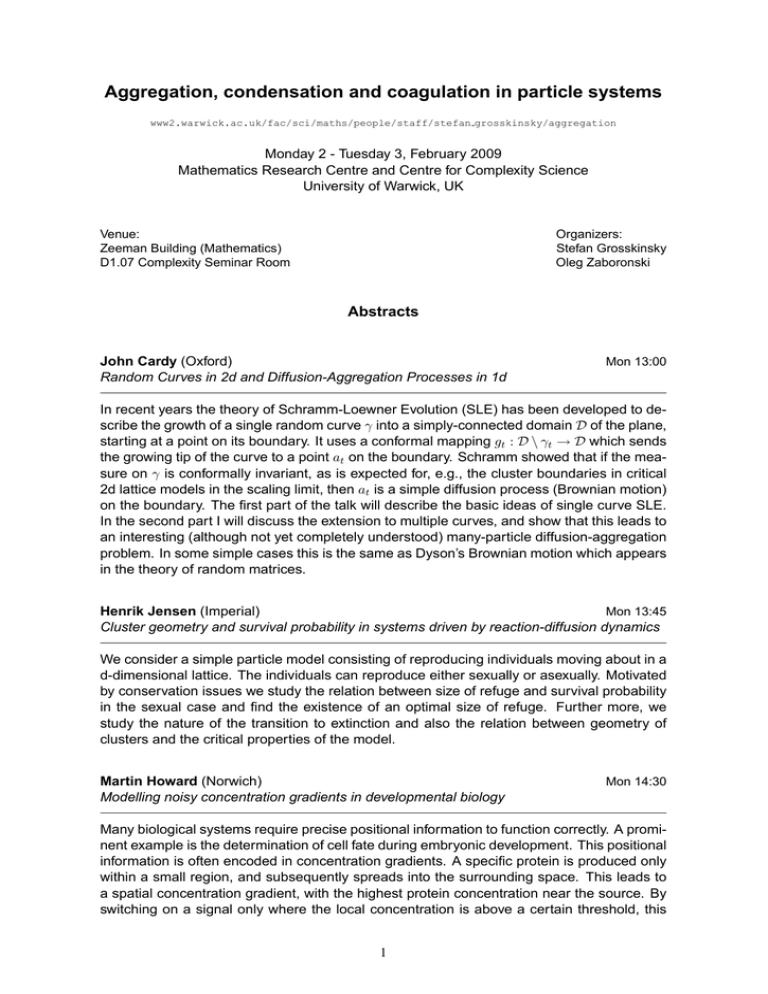
Aggregation, condensation and coagulation in particle systems www2.warwick.ac.uk/fac/sci/maths/people/staff/stefan grosskinsky/aggregation Monday 2 - Tuesday 3, February 2009 Mathematics Research Centre and Centre for Complexity Science University of Warwick, UK Venue: Zeeman Building (Mathematics) D1.07 Complexity Seminar Room Organizers: Stefan Grosskinsky Oleg Zaboronski Abstracts John Cardy (Oxford) Random Curves in 2d and Diffusion-Aggregation Processes in 1d Mon 13:00 In recent years the theory of Schramm-Loewner Evolution (SLE) has been developed to describe the growth of a single random curve γ into a simply-connected domain D of the plane, starting at a point on its boundary. It uses a conformal mapping gt : D \ γt → D which sends the growing tip of the curve to a point at on the boundary. Schramm showed that if the measure on γ is conformally invariant, as is expected for, e.g., the cluster boundaries in critical 2d lattice models in the scaling limit, then at is a simple diffusion process (Brownian motion) on the boundary. The first part of the talk will describe the basic ideas of single curve SLE. In the second part I will discuss the extension to multiple curves, and show that this leads to an interesting (although not yet completely understood) many-particle diffusion-aggregation problem. In some simple cases this is the same as Dyson’s Brownian motion which appears in the theory of random matrices. Henrik Jensen (Imperial) Mon 13:45 Cluster geometry and survival probability in systems driven by reaction-diffusion dynamics We consider a simple particle model consisting of reproducing individuals moving about in a d-dimensional lattice. The individuals can reproduce either sexually or asexually. Motivated by conservation issues we study the relation between size of refuge and survival probability in the sexual case and find the existence of an optimal size of refuge. Further more, we study the nature of the transition to extinction and also the relation between geometry of clusters and the critical properties of the model. Martin Howard (Norwich) Modelling noisy concentration gradients in developmental biology Mon 14:30 Many biological systems require precise positional information to function correctly. A prominent example is the determination of cell fate during embryonic development. This positional information is often encoded in concentration gradients. A specific protein is produced only within a small region, and subsequently spreads into the surrounding space. This leads to a spatial concentration gradient, with the highest protein concentration near the source. By switching on a signal only where the local concentration is above a certain threshold, this 1 gradient can provide positional information. However, intrinsic randomness in biochemical reactions will lead to unavoidable fluctuations in the concentration profile, which in turn will lead to fluctuations in the identified position. We therefore investigated how precisely a noisy concentration gradient can specify positional information. We found that both the kinetic parameters and the overall functional form of a concentration gradient can be optimised to generate maximally precise positional information. We have applied our results to development in the fruit fly Drosophila melanogaster. Markus Kraft (Cambridge) Coupling algorithms for calculating sensitivities of population balances Mon 16:00 We introduce a new class of stochastic algorithms for calculating parametric derivatives of the solution of the space-homogeneous Smoluchowski’s coagulation equation. Currently, it is very difficult to produce low variance estimates of these derivatives in reasonable amounts of computational time through the use of stochastic methods. These new algorithms consider a central difference estimator of the parametric derivative which is calculated by evaluating the coagulation equation at two different parameter values simultaneously, and causing variance reduction by maximising the covariance between these. The two different coupling strategies (’Single’ and ’Double’) have been compared to the case when there is no coupling (’Independent’). Both coupling algorithms converge and the Double coupling is the most ’efficient’ algorithm. For the numerical example chosen we obtain a factor of about 100 in efficiency in the best case (small system evolution time and small parameter perturbation). Joint work with: Peter Man and James Norris (Cambridge) Vassili Kolokoltsov (Warwick) Mon 16:45 Dynamic Law of Large Numbers and Central Limit Theorem with the estimates of error terms for Smoluchovski’s coagulation and Boltzmann collisions James Norris (Cambridge) Smoluchowski’s equation for Brownian coagulation Mon 17:30 I will discuss the relationship between stochastic and deterministic models for clouds of coagulating Brownian particles. Colm Connaughton Nonlocal mass cascades in cluster-cluster aggregation Tue 9:00 The generation of large clusters from smaller ones in cluster-cluster aggregation can be profitably thought of as a cascade process occuring in the space of cluster sizes. It transfers mass from the small scales (monomers) to the large scales (big clusters). Usually we picture this cascade as being local in the sense that the aggregation events responsible for the majority of the mass transfer tend to be between clusters of comparable size. This view breaks down if the cluster–cluster interaction rate increases too rapidly as a function of the cluster size leading to highly non-local interactions in the space of cluster sizes and interestingly pathological behaviour in the associated mean field kinetic theory such as the so-called ”instantaneous gelation”. In this talk I will present some analytical and numerical results from attempts to understand what happens as the cascade makes the transition from local to nonlocal interactions. This is joint work with O. Zaboronski and T. Stein. 2 Amanda Turner (Lancaster) Planar aggregation and the coalescing Brownian flow Tue 9:45 Diffusion limited aggregation (DLA) is a random growth model which was originally introduced in 1981 by Witten and Sander. This model is prevalent in nature and has many applications in the physical sciences as well as industrial processes. Unfortunately it is notoriously difficult to understand, and only one rigorous result has been proved in the last 25 years. We consider a simplified version of the Hastings-Levitov model of planar aggregation which is obtained by composing certain independent random conformal maps and show that the evolution of harmonic measure on the boundary of the cluster converges to the coalescing Brownian flow. Rosemary Harris (QMUL) Current fluctuations in stochastic particle systems with condensation Tue 11:00 I will discuss current fluctuations in stochastic particle systems with particular reference to the Zero Range Process (ZRP) which is a paradigmatic model exhibiting a condensation transition. For the partially asymmetric ZRP with open boundaries, it is found that the distribution of large current fluctuations does not satisfy the Gallavotti-Cohen symmetry indicating that such a breakdown can generally occur in systems with unbounded state space. Recent work on systems with memory-dependent rates will also be mentioned. Martin R. Evans (Edinburgh) Tue 11:45 Matrix representation of the stationary measure for the multispecies Asymmetric Simple Exclusion Process We consider a multispecies totally asymmetric exclusion process on the ring ZL. The stationary state of the model with two species of particle –first and second class particles where both species of particles hop forwards and exchange with holes but the second class particles are overtaken and interchange positions with the first class particles– has previously been solved using the matrix product formulation by Derrida, Janowsky, Lebowitz and Speer 1993. Also, probabilistic constructions of the steady state have been made by Ferrari, Fontes and Kohayakawa 1994, Angel 2006, Ferrari and Martin 2007, the latter introducing a queueing system interpretation of the stationary state. In this talk we demonstrate how the matrix product formulation and the queueing interpretation are equivalent. Further we show the stationary state for a system with any number of species of particles may be written in the matrix product formulation in a hierarchical fashion. Reference: Martin R. Evans, Pablo A. Ferrari, Kirone Mallick, Matrix representation of the stationary measure for the multispecies TASEP, arXiv:0807.0327 Tomohiro Sasamoto (Munich) The dynamics of a tagged particle in 1D TASEP Tue 13:30 The 1D TASEP is a many particle stochastic process in which particles hop only in one direction with exclusion interaction. We focus on the dynamics of a particular particle in TASEP (called the tagged particle) and discuss its fluctuation properties. Strong dependence on the initial conditions is observed. 3 Volker Betz (Warwick) Bose-Einstein condensation and infinite cycles in random permutations Tue 14:15 I present a model of random permutations on a set with spatial structure. The probability of obtaining a given permutation is determined by a Gibbs factor, and the energy is higher when the permutation contains more jumps between distant points of the underlying set. So, the jump length of a typical random permutation will be small. For this model I show the existence of a phase transition: Depending on the density of the points forming the spatial structure, there either exist exclusively finite cycles (for low density), or a coexistence of finite and macroscopic cycles (for high density). The physical relevance of the model comes from its connections to Bose-Einstein condensation; I will briefly explain these connections and highlight open question. 4
